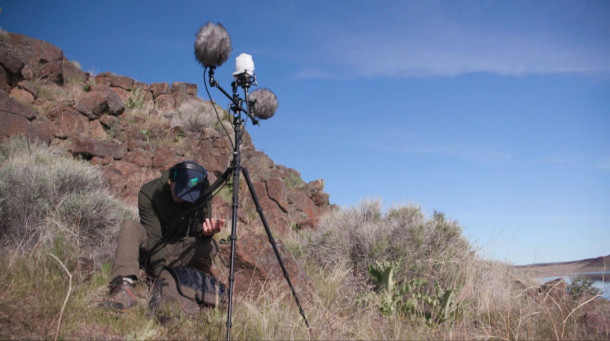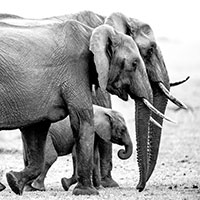A Quest for Quiet
Air Date: Week of March 28, 2025

Nick McMahan, sound recording artist. (Photo: Brandon Swanson, OPB)
The world can be an awfully noisy place. Ed Jahn of Oregon Public Broadcasting took a journey in search of silence and found what could be the quietest place in Oregon.
Transcript
DOERING: It’s Living on Earth, I’m Jenni Doering.
CURWOOD: And I’m Steve Curwood. The world can be an awfully noisy place. Many neighborhoods hum with the constant noise of leaf blowers, construction equipment and revving cars. So you might wonder where you can go to escape all that racket. Ed Jahn of Oregon Public Broadcasting took a journey in search of silence, and found what could be the quietest place in Oregon.
JAHN: There are more than 8 billion people on this planet. And we make a lot of noise.
(Open scene/ kids scream, band noise, concert)
JAHN: There is relief, though, according to a noise model developed by the research firm Ambient Logic in conjunction with the National Park Service. The model identified a location in southeast Oregon that could be the quietest place in the state. But it’s never been ground-truthed.
(open scene…car door, drive off)
JAHN: To see if the model lived up to the hype, I left the cacophony of Portland to join Nick McMahan, a specialist in natural sound recording. We met at Malheur National Wildlife Refuge to record the kind of noise most people don’t object to.
(bird song)
MCMAHAN: Initially, I came here two years ago and it was fascinating sounds- the birds I'd never heard before, and I think we're starting to hear them picking up again, which is exciting for me. You can kind of hear it settling even, between the wind, you can start hearing the communication between the animals and just the silence really starts to feel like a part of a you too. You kind of feel that settling. It's just really beautiful.
(bird song)
JAHN: These birds were hitting in the mid-40’s on our decibel meter. In contrast, a passing truck we measured in Burns on our way here spiked above 90.
(truck passing)
MCMAHAN: 93! That was a good one. It’s interesting because human conversation is kind of known to be around 60 decibels. Here that car that just went by was at like 73, which means we have to talk a little louder to be able to hear each other, right?
(truck passing)
JAHN: But to get to the quietest place in Oregon identified by the noise model meant driving for hours through southeast Oregon on dirt roads and then on a faint two-track that cut across sweeping hills full of fragrant sagebrush.
JAHN: Wow. This is a blank spot on the map for sure. I think we're going to park it and huff it. Then, we hiked. We hadn’t seen any signs of people for hours by the time we made it to a region known as the Basque Hills. It was a lovely spot, but mostly, kind of barren. Nothing worthy of National Park status.
MCMAHAN: This whole place is very subtle, the lack of lights on the horizon, that's really hard to find anywhere. We're seeing for 40 miles, we're at 5,000 feet and you can't see a single light.
JAHN: McMahan’s interest in places like this stems from his work with Quiet Parks International, an organization at the center of an increasingly popular movement to preserve quiet places.
MCMAHAN: It's, it’s almost like meeting like a human need as we're losing quiet spaces. It meets the need of people to have that awareness of listening and of being in quiet when they have an opportunity to. It's surprisingly few and far between.
JAHN: It took us a few football fields of hiking before we reached the exact coordinates identified by the noise model.
MCMAHAN: This is it.
JAHN: Oh, nice.
MCMAHAN: Right here.
JAHN: Sweet.
MCMAHAN: Hey, this is the quietest spot in Oregon.
JAHN: McMahan set up his recording equipment as our decibel reader hit about 30. That’s about as low as we could expect our off-the-shelf model to accurately measure.
MCMAHAN: Silence through a microphone is tricky, because it’s the lack of sound and that’s also part of the challenge and the excitement of it, is trying to figure that out.
JAHN: For a while, an audible breeze made this place seem not all that special. But then, the sun went down and the wind stopped. Now if you’re listening in your car or while out on a jog you might want to pull over or press those headphones to your head, because this is what McMahan recorded overnight.
(:05 of quiet)
JAHN: The almost total silence of the pre-dawn hours was followed by birds and coyotes waking at dawn.
(birds chirping and coyotes howling)
JAHN: And then near-silence again as the sun came up. If there is a quieter place on earth, it’s unlikely any human ears could tell the difference.
CURWOOD: Ed Jahn of Oregon Public Broadcasting produced that story as part of its Oregon Field Guide series.
Links
Read more about Oregon’s Basque Hills
Hear this story on Oregon Public Broadcasting’s website
Oregon Public Broadcasting | “The World’s Largest ‘Dark Sky Sanctuary’ Is Now in Oregon”
Living on Earth wants to hear from you!
Living on Earth
62 Calef Highway, Suite 212
Lee, NH 03861
Telephone: 617-287-4121
E-mail: comments@loe.org
Newsletter [Click here]
Donate to Living on Earth!
Living on Earth is an independent media program and relies entirely on contributions from listeners and institutions supporting public service. Please donate now to preserve an independent environmental voice.
NewsletterLiving on Earth offers a weekly delivery of the show's rundown to your mailbox. Sign up for our newsletter today!
 Sailors For The Sea: Be the change you want to sea.
Sailors For The Sea: Be the change you want to sea.
 The Grantham Foundation for the Protection of the Environment: Committed to protecting and improving the health of the global environment.
The Grantham Foundation for the Protection of the Environment: Committed to protecting and improving the health of the global environment.
 Contribute to Living on Earth and receive, as our gift to you, an archival print of one of Mark Seth Lender's extraordinary wildlife photographs. Follow the link to see Mark's current collection of photographs.
Contribute to Living on Earth and receive, as our gift to you, an archival print of one of Mark Seth Lender's extraordinary wildlife photographs. Follow the link to see Mark's current collection of photographs.
 Buy a signed copy of Mark Seth Lender's book Smeagull the Seagull & support Living on Earth
Buy a signed copy of Mark Seth Lender's book Smeagull the Seagull & support Living on Earth

